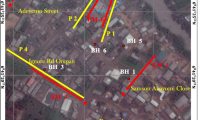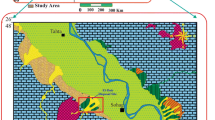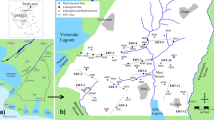Abstract
Groundwater contamination have been widely concerned. To reliably conduct risk assessment, it is essential to accurately delineate the contaminant distribution and hydrogeological condition. Electrical resistivity tomography (ERT) has become a powerful tool because of its high sensitivity to hydrochemical parameters, as well as its advantages of non-invasiveness, spatial continuity, and cost-effectiveness. However, it is still difficult to integrate hydrochemical, hydrogeological, and ERT datasets for risk assessment. In this study, we develop a general framework for risk assessment by sequentially jointing hydrochemical, hydrogeological, and ERT surveys, while establishing petrophysical relationships among these data. This framework can be used in groundwater-contaminated site and help to delineate the distribution of contaminants. In this study, it was applied to a nitrogen-contaminated site where field ERT survey and borehole information provided valuable measurement data for validating the consistency of contamination and hydrogeological condition. Risk assessment was conducted based on the refined results by the establishment of relationship between conductivity and contaminants concentration with \({R}^{2}>0.84\). The contamination source was identified and the transport direction was predicted with the good agreement of \({R}^{2}\) = 0.965 between simulated and observed groundwater head, which can help to propose measures for anti-seepage and monitoring. This study thus enhances the reliability of risk assessment and prediction through a thought-provoking innovation in the realm of groundwater environmental assessment.











Similar content being viewed by others
Data availability
Data will be made available on request.
References
Akiang FB, Emujakporue GO, Nwosu LI (2023) Leachate delineation and aquifer vulnerability assessment using geo-electric imaging in a major dumpsite around Calabar Flank Southern Nigeria. Environ Monit Assess 195(1):123
Archie GE (1942) The electrical resistivity log as an aid in determining some reservoir characteristics. Trans Am Inst Min Metall Pet Eng 146:54–62
Balasco M, Lapenna V, Rizzo E, Telesca L (2022) Deep electrical resistivity tomography for geophysical investigations: the state of the art and future directions. Geosciences 12(12):438
Binley A, Slater L (2020) Resistivity and induced polarization: theory and applications to the near-surface Earth. Cambridge University Press, Cambridge
Calò F, Parise M (2009) Waste management and problems of groundwater pollution in karst environments in the context of a post-conflict scenario: the case of Mostar (Bosnia Herzegovina). Habitat Int 33(1):63–72
Chu Y, Liu S, Wang F, Cai G, Bian H (2017) Estimation of heavy metal-contaminated soils’ mechanical characteristics using electrical resistivity. Environ Sci Pollut R 24(15):13561–13575
de Barros FPJ, Bellin A, Cvetkovic V, Dagan G, Fiori A (2016) Aquifer heterogeneity controls on adverse human health effects and the concept of the hazard attenuation factor. Water Resour Res 52(8):5911–5922
Egbueri JC, Agbasi JC (2022) Data-driven soft computing modeling of groundwater quality parameters in southeast Nigeria: comparing the performances of different algorithms. Environ Sci Pollut R 29(25):38346–38373
Fei JC, Min XB, Wang ZX, Pang ZH, Liang YJ, Ke Y (2017) Health and ecological risk assessment of heavy metals pollution in an antimony mining region: a case study from South China. Environ Sci Pollut R 24(35):27573–27586
Flores-Orozco A, Gallistl J, Steiner M, Brandstätter C, Fellner J (2020) Mapping biogeochemically active zones in landfills with induced polarization imaging: the Heferlbach landfill. Waste Manage 107:121–132
Fu HY, Ding DX, Sui Y, Zhang H, Hu N, Li F, Dai ZR, Li GY, Ye YJ, Wang YD (2019) Transport of uranium(VI) in red soil in South China: influence of initial pH and carbonate concentration. Environ Sci Pollut R 26(36):37125–37136
Glover PWJ (2009) What is the cementation exponent? A new interpretation. Leading Edge 28:82–85
Golub GH, Loan CFV (1989) Matrix computations (2nd edn). Johns Hopkins University Press
Goyal D, Haritash AK, Singh SK (2021) A comprehensive review of groundwater vulnerability assessment using index-based, modelling, and coupling methods. J Environ Manag 296:113161
Han DM, Currell MJ, Cao GL (2016) Deep challenges for China’s war on water pollution. Environ Pollut 218:1222–1233
Hou D, Al-Tabbaa A, O’Connor D, Hu Q, Zhu YG, Wang L, Kirkwood N, Ok YS, Tsang DCW, Bolan NS, Rinklebe J (2023) Sustainable remediation and redevelopment of brownfield sites. Nat Eev Earth Env 4(4):271–286
Jain H (2023) Groundwater vulnerability and risk mitigation: a comprehensive review of the techniques and applications. Groundw Sustain Dev 22:100968
Karunanidhi D, Aravinthasamy P, Subramani T, Kumar D, Venkatesan G (2021) Chromium contamination in groundwater and Sobol sensitivity model based human health risk evaluation from leather tanning industrial region of South India. Environ Res 199:111238
Krcmar D, Tenodi S, Grba N, Kerkez D, Watson M, Roncevic S, Dalmacija B (2018) Preremedial assessment of themunicipal landfill pollution impact on soil and shallow groundwater in Subotica, Serbia. Sci Total Environ 615:1341–1354
Kumar P, Tiwari P, Biswas A, Acharya T (2023) Geophysical investigation for seawater intrusion in the high-quality coastal aquifers of India: a review. Environ Sci Pollut R 30(4):9127–9163
Lawniczak AE, Zbierska J, Nowak B, Achtenberg K, Grzeskowiak A, Kanas K (2016) Impact of agriculture and land use on nitrate contamination in groundwater and running waters in central-west Poland. Environ Monit Assess 188(3):172
Li P, Tian R, Xue C, Wu J (2017) Progress, opportunities, and key fields for groundwater quality research under the impacts of human activities in China with a special focus on western China. Environ Sci Pollut Res 24(15):13224–13234
Liu FM, Yi SP, Ma HY, Huang JY, Tang YK, Qin JB, Zhou WH (2019) Risk assessment of groundwater environmental contamination: a case study of a karst site for the construction of a fossil power plant. Environ Sci Pollut R 26(30):30561–30574
Loke MH, Acworth I, Dahlin T (2003) A comparison of smooth and blocky inversion methods in 2D electrical imaging surveys. Explor Geophys 34(3):182–187
Loke MH, Barker RD (1996) Rapid least-squares inversion of apparent resistivity pseudosections by a quasi-Newton method. Geophys Prospect 44:131–152
Loke MH, Wilkinson PB, Chambers JE (2010) Fast computation of optimized electrode arrays for 2D resistivity surveys. Comput Geosci 36(11):1414–1426
Mao D, Lu L, Revil A, Zuo Y, Hinton J, Ren ZJ (2016) Geophysical monitoring of hydrocarbon-contaminated soils remediated with a bioelectrochemical system. Environ Sci Technol 50:8205–8213
Mao DQ, Wang XD, Meng J, Ma XM, Jiang XW, Wan L, Yan HB, Fan Y (2022) Infiltration assessments on top of yungang grottoes by time-lapse electrical resistivity tomography. Hydrology 9(5):77
Mary B, Sottani A, Boaga J, Camerin I, Deiana R, Cassiani G (2023) Non-invasive investigations of closed landfills: an example in a karstic area. Sci Total Environ 905:167083
Maurya PK, Ronde VK, Fiandaca G, Balbarini N, Auken E, Bjerg PL, Christiansen AV (2017) Detailed landfill leachate plume mapping using 2D and 3D electrical resistivity tomography - with correlation to ionic strength measured in screens. J Appl Geophys 138:1–8
McCall W, Christy TM (2020) The hydraulic profiling tool for hydrogeologic investigation of unconsolidated formations. Ground Water Monit R 40(3):89–103
McDnonald MG, Harbaugh AE (1988) A modeular three-dimensional finite- difference groundwater flow model. US Geological Survey Open File Report, 83–875 chap. A1 586 p.
Meng J, Dong YH, Xia T, Ma XM, Gao CL, Mao DQ (2022a) Detailed LNAPL plume mapping using electrical resistivity tomography inside an industrial building. Acta Geophys 70(4):1651–1663
Meng J, Zhang JM, Mao DQ, Han CM, Guo LL, Li SP, Chao C (2022b) Organic contamination distribution constrained with induced polarization at a waste disposal site. Water 14(22):3630
Naudet V, Revil A, Rizzo E, Bottero JY, Bégassat P (2004) Groundwater redox conditions and conductivity in a contaminant plume from geoelectrical investigations. Hydrol Earth Syst Sci 8(1):8–22
Orellana-Macías JM, Roselló MJP, Causapé J (2021) A methodology for assessing groundwater pollution hazard by nitrates from agricultural sources: application to the Gallocanta Groundwater Basin (Spain). Sustain 13(11):6321
Persaud E, Levison J (2021) Impacts of changing watershed conditions in the assessment of future groundwater contamination risk. J Hydrol 603(D):127142.
Revil A, Glover PWJ (1997) Theory of ionic-surface electrical conduction in porous media. Phys Rev B 55(3):1757–1773
Rogers KM, Van der Raaij R, Phillips A, Stewart M (2023) A national isotope survey to define the sources of nitrate contamination in New Zealand freshwaters. J Hydrol 617(C):129131
Sankoh AA, Laar C, Derkyi NSA, Frazer-Williams R (2023) Application of stable isotope of water and a Bayesian isotope mixing model (SIMMR) in groundwater studies: a case study of the Granvillebrook and Kingtom dumpsites. Environ Monit Assess 195(5):548
Sanuade OA, Arowoogun KI, Amosun JO (2022) A review on the use of geoelectrical methods for characterization and monitoring of contaminant plumes. Acta Geophys 70(5):2099–2117
Siddiqua A, Hahladakis JN, Al-Attiya WAKA (2022) An overview of the environmental pollution and health effects associated with waste landfilling and open dumping. Environ Sci Pollut R 29(39):58514–58536
Sims JL, Stroski KM, Kim S, Killeen G, Ehalt R, Simcik MF, Brooks BW (2022) Global occurrence and probabilistic environmental health hazard assessment of per- and polyfluoroalkyl substances (PFASs) in groundwater and surface waters. Sci Total Environ 816:151535
Torkashvand M, Neshat A, Javadi S, Pradhan B (2021) New hybrid evolutionary algorithm for optimizing index-based groundwater vulnerability assessment method. J Hydrol 598:126446
Wilkinson PB, Meldrum PI, Chambers JE, Kuras O, Ogilvy RD (2006) Improved strategies for the automatic selection of optimized sets of electrical resistivity tomography measurement configurations. Geophys J Int 167(3):1119–1126
Xia T, Dong Y, Mao D, Meng J (2021) Delineation of LNAPL contaminant plumes at a former perfumery plant using electrical resistivity tomography. Hydrogeol J 29(3):1189–1201
Xu BW, Noel M (1993) On the completeness of data sets with multielectrode systems for electrical-resistivity survey. Geophys Prospect 41(6):791–801
Yin X, Jiang BL, Feng ZX, Yao BK, Shi XQ, Sun YY, Wu JC (2017) Comprehensive evaluation of shallow groundwater quality in Central and Southern Jiangsu Province China. Environ Earth Sci 76(11):400
Yu SY, Lee PK, Huang SI (2015) Groundwater contamination with volatile organic compounds in urban and industrial areas: analysis of co-occurrence and land use effects. Environ Earth Sci 74(4):3661–3677
Zhai Y, Zhao X, Teng Y, Li X, Zhang J, Wu J, Zuo R (2017) Groundwater nitrate pollution and human health risk assessment by using HHRA model in an agricultural area, NE China. Ecotoxicol Environ Saf 137:130–142
Zheng C, Wang PP (1999) MT3DMS: a modular three-dimensional multispecies transport model for simulation of advection, depersion and chemical reactions of contaminants in groundwater systems. Documentation and User’s Guide, Contract Report SERDP-99–1, U.S. Army Engineer Research and Development Center
Funding
This work was supported by the National Natural Science Foundation of China (grant number 42177056). The fund contributes to the framework design, field surveys, analysis, and interpretation of data.
Author information
Authors and Affiliations
Contributions
Jian Meng: visualization, writing—original draft, investigation. Kaiyou Hu: software, validation. Shaowei Wang: supervision, formal analysis. Yaxun Wang: investigation, writing—reviewing and editing. Zifang Chen: project administration. Cuiling Gao: data curation. Deqiang Mao: conceptualization, funding acquisition, methodology, resources.
Corresponding author
Ethics declarations
Ethics approval
All analyses are based on publicly available data and therefore do not require ethical approval.
Consent to participate
All authors gave their consent to participate in this study.
Consent for publication
All authors approved the final manuscript and the submission to this journal.
Competing interests
The authors declare no competing interests.
Additional information
Responsible Editor: Xianliang Yi
Publisher's Note
Springer Nature remains neutral with regard to jurisdictional claims in published maps and institutional affiliations.
Supplementary Information
Below is the link to the electronic supplementary material.
Rights and permissions
Springer Nature or its licensor (e.g. a society or other partner) holds exclusive rights to this article under a publishing agreement with the author(s) or other rightsholder(s); author self-archiving of the accepted manuscript version of this article is solely governed by the terms of such publishing agreement and applicable law.
About this article
Cite this article
Meng, J., Hu, K., Wang, S. et al. A framework for risk assessment of groundwater contamination integrating hydrochemical, hydrogeological, and electrical resistivity tomography method. Environ Sci Pollut Res 31, 28105–28123 (2024). https://doi.org/10.1007/s11356-024-33030-5
Received:
Accepted:
Published:
Issue Date:
DOI: https://doi.org/10.1007/s11356-024-33030-5




